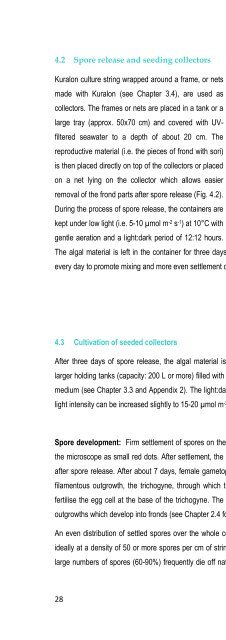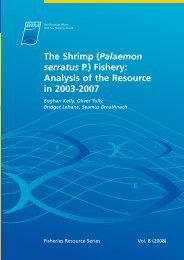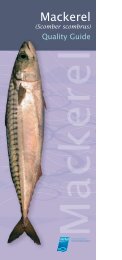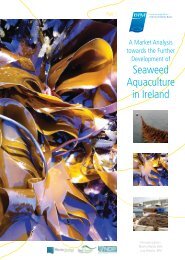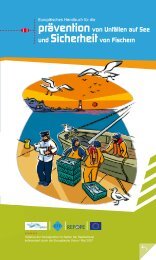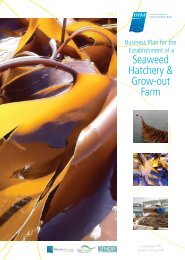Cultivating Palmaria palmata - Bord Iascaigh Mhara
Cultivating Palmaria palmata - Bord Iascaigh Mhara
Cultivating Palmaria palmata - Bord Iascaigh Mhara
Create successful ePaper yourself
Turn your PDF publications into a flip-book with our unique Google optimized e-Paper software.
4.2 Spore release and seeding collectors<br />
Kuralon culture string wrapped around a frame, or nets<br />
made with Kuralon (see Chapter 3.4), are used as<br />
collectors. The frames or nets are placed in a tank or a<br />
large tray (approx. 50x70 cm) and covered with UV-<br />
filtered seawater to a depth of about 20 cm. The<br />
reproductive material (i.e. the pieces of frond with sori)<br />
is then placed directly on top of the collectors or placed<br />
on a net lying on the collector which allows easier<br />
removal of the frond parts after spore release (Fig. 4.2).<br />
During the process of spore release, the containers are<br />
kept under low light (i.e. 5-10 µmol m -2 s -1 ) at 10°C with<br />
gentle aeration and a light:dark period of 12:12 hours.<br />
The algal material is left in the container for three days, but should be gently stirred in the tank by hand once<br />
every day to promote mixing and more even settlement of spores on the collectors.<br />
4.3 Cultivation of seeded collectors<br />
After three days of spore release, the algal material is removed and the seeded collectors are transferred to<br />
larger holding tanks (capacity: 200 L or more) filled with UV-filtered seawater and supplemented with enrichment<br />
medium (see Chapter 3.3 and Appendix 2). The light:dark period and temperature should be maintained but the<br />
light intensity can be increased slightly to 15-20 µmol m -2 s -1 .<br />
Spore development: Firm settlement of spores on the string occurs in a few days. Spores can be seen under<br />
the microscope as small red dots. After settlement, the spores start to divide, and divisions are visible 3-4 days<br />
after spore release. After about 7 days, female gametophytes are recognisable as small cell aggregates with a<br />
filamentous outgrowth, the trichogyne, through which the spermatia from the male gametophyte will travel to<br />
fertilise the egg cell at the base of the trichogyne. The male gametophyte shows at this stage some hump-like<br />
outgrowths which develop into fronds (see Chapter 2.4 for development of spores).<br />
An even distribution of settled spores over the whole collector is desirable for successful ongrowth in the sea,<br />
ideally at a density of 50 or more spores per cm of string. During the first two weeks after settlement, however,<br />
large numbers of spores (60-90%) frequently die off naturally. The reasons for this high mortality of spores are<br />
28<br />
Fig. 4.2. Spore release from <strong>Palmaria</strong>: fertile pieces of<br />
fronds placed on top of a collector carrying 2 nets.


